Federal Resumes Guide for USAJobs
Table of Contents
Introduction to Federal Resumes
Searching for a federal job can be a daunting task. The stringent guidelines for both the application process and the formatting of required materials, including the federal resume, can seem overwhelming to first-time applicants and seasoned professionals.
In this comprehensive guide, we will walk you through the key steps in the application process, including successfully navigating USAJOBS (the official job-search website of the US government), targeting vacancy postings, and crafting an effective resume that highlights your career accomplishments while aligning with federal resume-writing best practices.
How a Federal Resume Differs From a Private Industry Resume
The main differences between a federal resume and a private sector resume are the length of the resume and the detail involved. While a typical resume should be no more than two pages in length, a federal resume can extend to five pages or more. In addition, federal resumes require more details in regards to references, availability, and expanded job descriptions and accomplishments. Also, readers of your federal resume will be expecting certain stylistic attributes and exact phrasing that mirrors the language of vacancy postings on USAJOBS.gov.
Grade Levels: General Schedule (GS) & Senior Executive Service (SES)
In the federal job arena, there is a highly specific and expected career progression and salary roadmap referred to as the GS pay scale, ranging from GS-1 through GS-15. Applicants are required to meet clearly defined expectations for jobs at each level, and each progressive step includes a raise in salary:
- GS-1 through GS-7: Entry-level positions – If you have recently entered the workforce and have at least a high school diploma and a few months of work experience, you qualify for positions up to GS-2. If you have more than a few months of general experience, you qualify for GS-3 and GS-4 levels. Following this (GS-5 and above), positions require at least 1 year of specialized experience to be considered. Graduates within a specific career field are eligible for GS-5 jobs and qualify for GS-7 if they attained certain grades, test scores, or other criteria while in college.
- GS-8 through GS-12: Mid-level positions – Jobs within this range typically require master’s degrees or a doctorate for GS-11 grades and beyond. In lieu of a degree, acceptable candidates can qualify with at least 12 months of experience at an equivalent grade level.
- GS-13 through GS-15: Senior managers, high-level technical specialists, physicians – Positions in this range are typically reserved for top professionals holding advanced degrees. Candidates must be able to demonstrate relevant job experience. At levels 14 and 15, the candidate is eligible to apply for a Senior Executive Service (SES) job.
SES & Executive Core Qualifications (ECQs)
SES roles represent executive-level positions across management and policy. These roles are classified above GS-15 in most Executive Branch agencies of the US government. These also represent the highest-level positions below presidential appointments. To qualify for an SES position, one must demonstrate alignment with five ECQs and their key components:
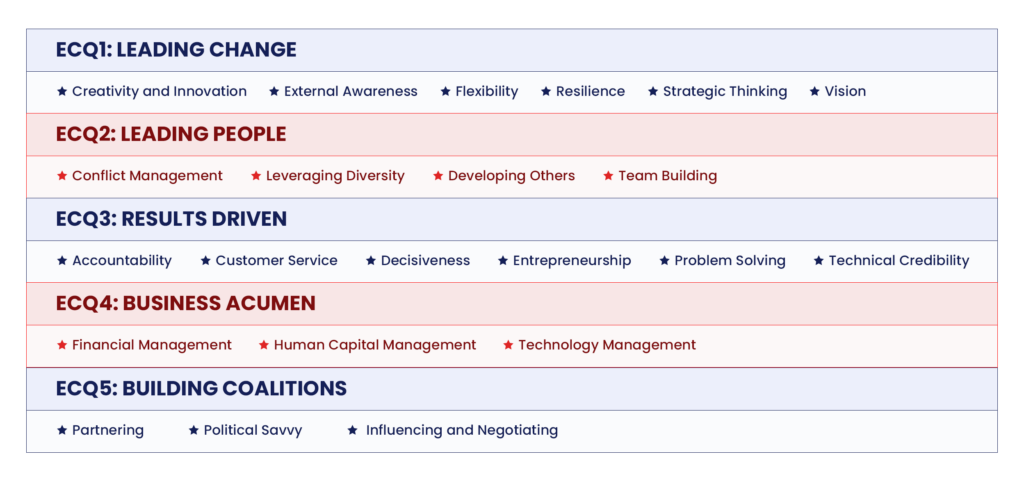
Each of these qualifications requires specific language that will need to be incorporated into a federal resume aimed at landing an SES job. We will discuss this at greater length later in this guide.
Knowledge, Skills, and Abilities (KSAs)
While ECQs are specific to SES-level positions, KSAs are a key component of federal resumes at all levels. Naturally, you will want your KSAs to align with those of the vacancy posting so that you’ll be considered for your next position, and this is where adept usage of USAJOBS.gov comes in handy. HR specialists who review your resume will be looking for highly specific KSA phrasing, so your resume prose must be constructed to meet expectations and qualifications.
What is USAJOBS?
An official website of the US government, USAJOBS is the primary resource for federal employees looking for jobs. Although this might seem limiting, the advantage of one all-inclusive resource is that it can make the process of applying to positions relatively straightforward once you understand the ins and outs of the website. It also means that an applicant doesn’t need to navigate countless job search resources to find a desirable position.
In addition to hosting the vast majority of government job postings, USAJOBS also has extensive resources available regarding the nuances of jobs within the government as well as a database of terminology and FAQs to assist the federal job hunter.
How Do I Use It?
The first step to leveraging USAJOBS is to create an account, ensuring that you fill out all of the required information, including the profile and preference sections. It’s critical that you provide detailed, accurate contact information. Since you are on the hunt for your next challenge, make sure to enable the “Make Your Resume Searchable” feature so that agencies can find and reach out to you.
Resume Builder
Resume Builder is a feature of USAJOBS that allows the user to build components of their resume online rather than providing a full document for submission. Some federal jobs require this feature, so it’s important to review the vacancy posting to see if you’ll need to provide your resume in this format. Given the complexities of resume writing and the need to tailor the document to a specific position, it’s necessary to draft a standalone document that can later be uploaded to the Resume Builder. Later in this guide, we will discuss a few tricks to make your document easy to convert and upload to the Resume Builder if it’s required.
Creating a Search Agent
The USAJOBS Jobs Search Agent is an automated system that assists the user in locating jobs within specific areas of interest. After you establish the specifications most important to you, it will email you jobs that match your preferences. You can create a search agent within the “My Account” screen.
Navigating a USAJOBS Vacancy Posting
As with a private industry resume, you want to ensure that your federal resume utilizes keywords that are prominent in the vacancy posting. However, as mentioned previously in this guide, there are stringent parameters regarding the presentation of keywords and phrases. In a federal resume, keywords usually appear as category titles for your bullets.
Highly specific verbiage aligning the federal resume with the vacancy posting is expected throughout the document. Although the description of duties can be paraphrased while maintaining important terminology, KSAs must be verbatim.
Before writing the resume, review the vacancy posting and applicant questionnaire and create a list of all of the necessary verbiage and KSAs that are required for the job. Below are excerpts from a posting for a GS-14 level Program Manager.
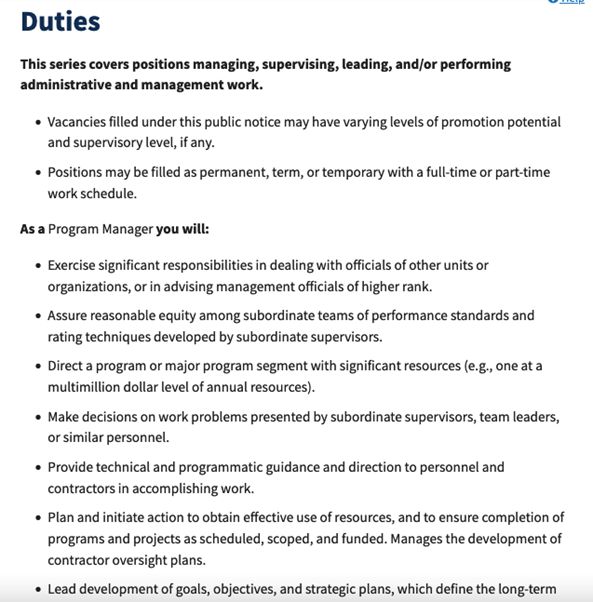
In a targeted, effective federal resume, you must ensure that all of the phrases under “As a Program Manager you will” are utilized in your document, tailored to how you leverage your abilities to accomplish these things. You can add to this list by reviewing the questionnaire that appears with the job posting:
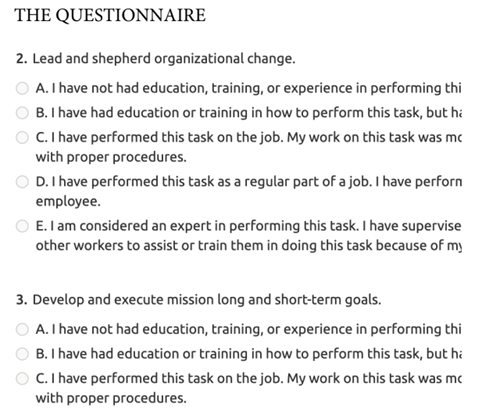
As you’ll see, the questionnaire asks about certain abilities that the ideal candidate would possess that might not be spelled out in the job posting itself, so it’s important to identify these and leverage them in your federal resume.
In addition to specific phrasing of expected abilities and accomplishments, you will want to identify the KSAs that are specific to the position. USAJOBS makes this process easy by highlighting them at the bottom of a vacancy posting with the “How You Will Be Evaluated” section. Remember, these are expected to be written verbatim in a federal resume.

After you have made a list of both the KSAs and phrases you need to incorporate into your federal resume, it’s time to start writing.
Strategies for Writing a Successful Federal Resume
Define Your Core Skills
With your list of KSAs and duty phrases in hand, ask yourself what five high-level responsibilities describe your current role in order to define the key knowledge, skills, and abilities you apply every day and how they align with the information you obtained from the vacancy posting. Once you have compiled this list, brainstorm about specific examples of achievements in these areas and how they support the position you’re applying to as well as its KSAs.
If you are making a transition from military service into civilian service, you will need to translate your experience and accomplishments to align with the language of the vacancy postings. Using the posting language and KSAs as a guide, consider how your accomplishments within the military reflect the skills and abilities required for the position. A good starting point for this information is your performance evaluations.
Formatting & Layout
As with a private industry resume, a federal resume is most impactful when it is organized and highly readable. A main point of difference between the two is that while a private resume can take many forms including functional or creative, the federal resume must be in the traditional reverse-chronological order covering the last 10 years. Private sector resumes use succinct career highlights and bullets with few details, whereas federal resumes use full phrases, sentences, and paragraphs to cover the informative descriptions and extensive details that support the job qualifications. While a private sector resume is typically limited to 2 pages, a federal resume can average anywhere from 3 pages to 7 or more.
Stylistic Rules
As with private-sector resumes, some general stylistic rules apply to optimize the document:
- Most jobs will have four to six paragraphs, and each should represent a KSA, if possible. “Communication skills” is the most common KSA.
- Each resume should contain one paragraph on “Interpreting Regulations.”
- Repetition aligning with job posting-specific phrasing is encouraged. If you did the work and have the skills, it’s acceptable to repeat these attributes throughout the resume. Avoid exact repetition, and paraphrase when possible.
- Minimize using personal pronouns, and keep articles such as “an” or “the” to a minimum to optimize space.
- KEYWORDS/CORE COMPETENCIES should be used to describe each duties paragraph and are in all caps. Nouns are preferred, but verbs can also be used if that is the language reflecting the vacancy posting.
- Accomplishments should follow the STAR format (Situation, Task, Action, Result) for a general federal resume or the CCAR (Challenge, Context, Action, Result) format for ECQs within the SES resume.
- Some job announcements will require the full date (mm/dd/yyyy) and salary, supervisor name and phone, and whether or not to contact. It’s important to note that federal resumes will not be considered if required information is missing.
- Certificates usually go under Job-Related Training, but longer programs such as the Project Management Institute’s (PMI) Project Management Professional (PMP) certification will go under education.
- Military, Soldier, Veteran, Marine, etc. are capitalized throughout the resume, which is reflective of Military AP Style.
- All acronyms, except those that are obvious, should be spelled out. This is especially important to elucidate department or industry-specific jargon. Remember that it’s often HR that is reviewing your resume first, not a specialist within your field.
- Font size and spacing should remain the same, except for paragraph spacing.
- Jobs more than 10 years in the past will still be listed but will be presented in the Additional Information section, with the number of years listed instead of dates.
Contact Information & Career Summary
The federal resume presentation begins with your contact information. These details should match your profile on USAJOBS. Following this is the Career Summary which should be crafted to align your experience with the vacancy posting of interest. Also list your citizenship status, current employment status (federal or private sector), the highest GS level you have obtained (if applicable), and any security clearances you have.
If you don’t have the security clearance required by the position, make it known that you are aware of the requirement and are willing to obtain the necessary clearance. You can also use this space to describe any high-level awards you have received or technical skills that are relevant to your desired position. Again, while the private sector resume is intentionally two pages on average, federal resumes are more expansive and inclusive of details.
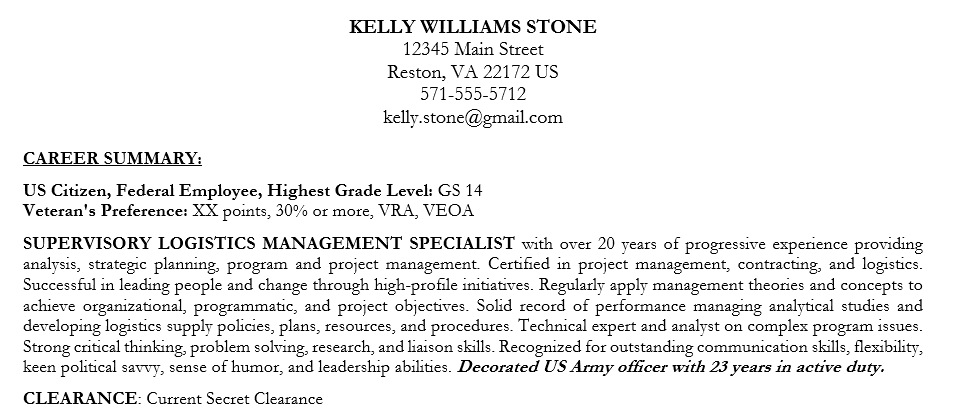
Following your summary and contact information is a section of bulleted areas of expertise. Again, focus on the keywords that align your strengths and abilities with the requirements outlined in the vacancy posting.


Work Experience
Next, outline your work experience for each agency in chronological order. The federal resume requires exact dates (month/year) of employment as well as hours worked per week and exact details of each position (Series, GS level, etc.). As stated previously, the federal resume is a chronological document that describes your work history in terms of an outline. This means that you should outline your progression of roles within that agency and follow the timeline with a skills-based resume-writing format. You will do this for each applicable agency.
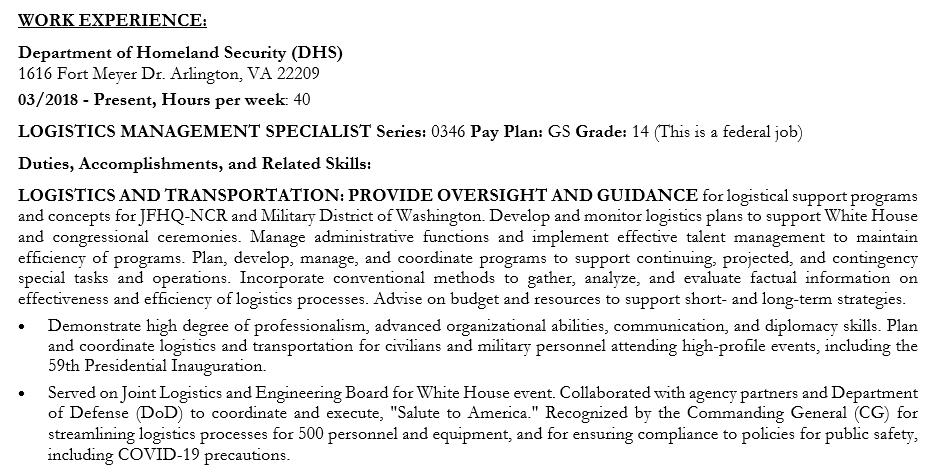
Next, use the list of duties and KSAs that you compiled from the vacancy posting as a template to describe how your career duties and accomplishments demonstrate your success in those areas. In this applicant’s case, the following phrases (among others) were listed on the vacancy posting:
- Logistics and transportation
- Provide oversight and guidance
- Leverage knowledge of organizational development and culture
- Team leader
- Organize and direct teams
- Interpret policy and regulations
- Effective written and oral communication
- Build professional working relationships
Looking at the example below, you can see how the resume entry has been customized to reflect these lists:
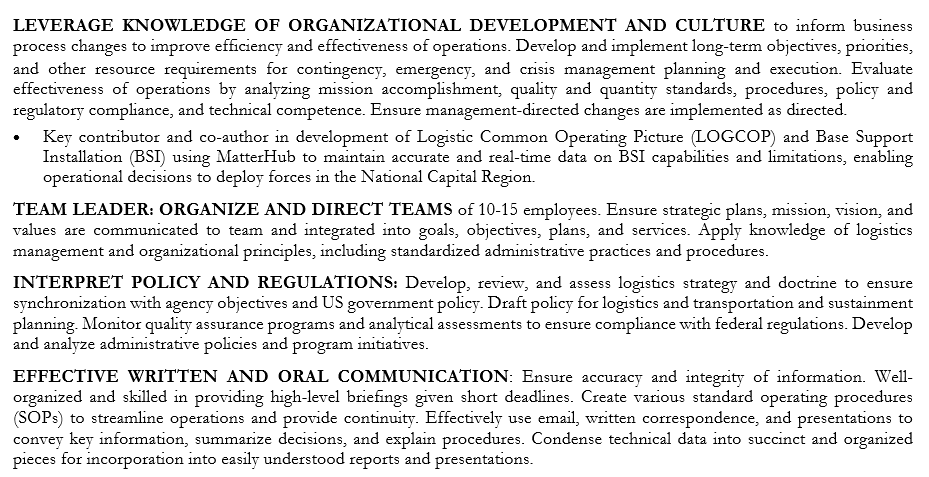
As with a private sector resume, you’ll notice the use of bulleted accomplishments to describe specific accomplishments related to the listed and described skills. These should describe both what you accomplished as well as how you did it.
You will go through this process with every agency within your career history, ensuring that you continue to frame your accomplishments and work history around the list of phrases and KSAs that you obtained from your review of the vacancy posting.
It is also customary to list your supervisors as references under each position in your job history. You should also specify whether the HR specialist reviewing your resume can contact them.
Additional Information
After outlining and describing your career history in a way that aligns with your desired position, you will list additional information that is important and relevant, including education, certifications, job-related training, professional affiliations, and publications. This is also where older employment information is listed without specific dates.

Some higher-level applicants (in particular in the GS-14 and GS-15 range) have exhaustive lists of publications that would significantly lengthen the document. In this case, it is perfectly acceptable to present a selected list of representative publications.
More on SES Jobs
The SES level was established in 1978 as part of the Civil Service Reform Act to provide executive management of 75 federal agencies that are managed by the US Office of Personnel Management (OPM). As previously discussed, SES jobs represent the highest-level federal positions second to presidential appointments.
Although the same general rules of writing a strong federal resume apply, SES jobs have more expansive requirements for application. Depending on the vacancy posting, there are three kinds of SES applications:
- Traditional Method: 10-page ECQs in the proper format, technical qualifications (TQs) separate, and federal resume.
- Resume Only: 5-page traditional federal resume incorporating the five ECQs and, if relevant, TQs.
- Accomplishment Record: Resume and narratives responding to specific guidance for each submission.
ECQS and TQs, like KSAs, must be listed verbatim in your documents. The same procedures apply to an SES resume as with a general federal resume, but the scope is larger and the requirements more specific. If the vacancy post you’re interested in requires the traditional method, you’ll need to craft both a traditional resume as well as a 10-page document outlining how your experience aligns with the five ECQs (and TQs if a technically oriented position).
Resume Builder Compatibility
Because some vacancy postings require resume submission via the Resume Builder, it’s important to format your document so that it can be easily converted to Resume Builder style. If you have followed the general federal resume-writing practices outlined in this guide, then the process of converting to a Resume Builder-friendly format is fairly straightforward. When drafting a federal resume, it’s recommended to have two versions ready to go: your traditional federal resume and a simpler document that is ready for the resume builder.
Resume Builder is a simple text-only interface, so it’s necessary to avoid any graphics or fanciful formatting that won’t translate well to the system. Text styling such as italics, bolding, underlining, or bullets also do not register with Resume Builder, so these will need to be adjusted when converting your document. Additionally, you will need to remove detailed information about each position that will need to be entered manually, such as employment dates, hours worked, and pay grade.

Federal Resume Sample
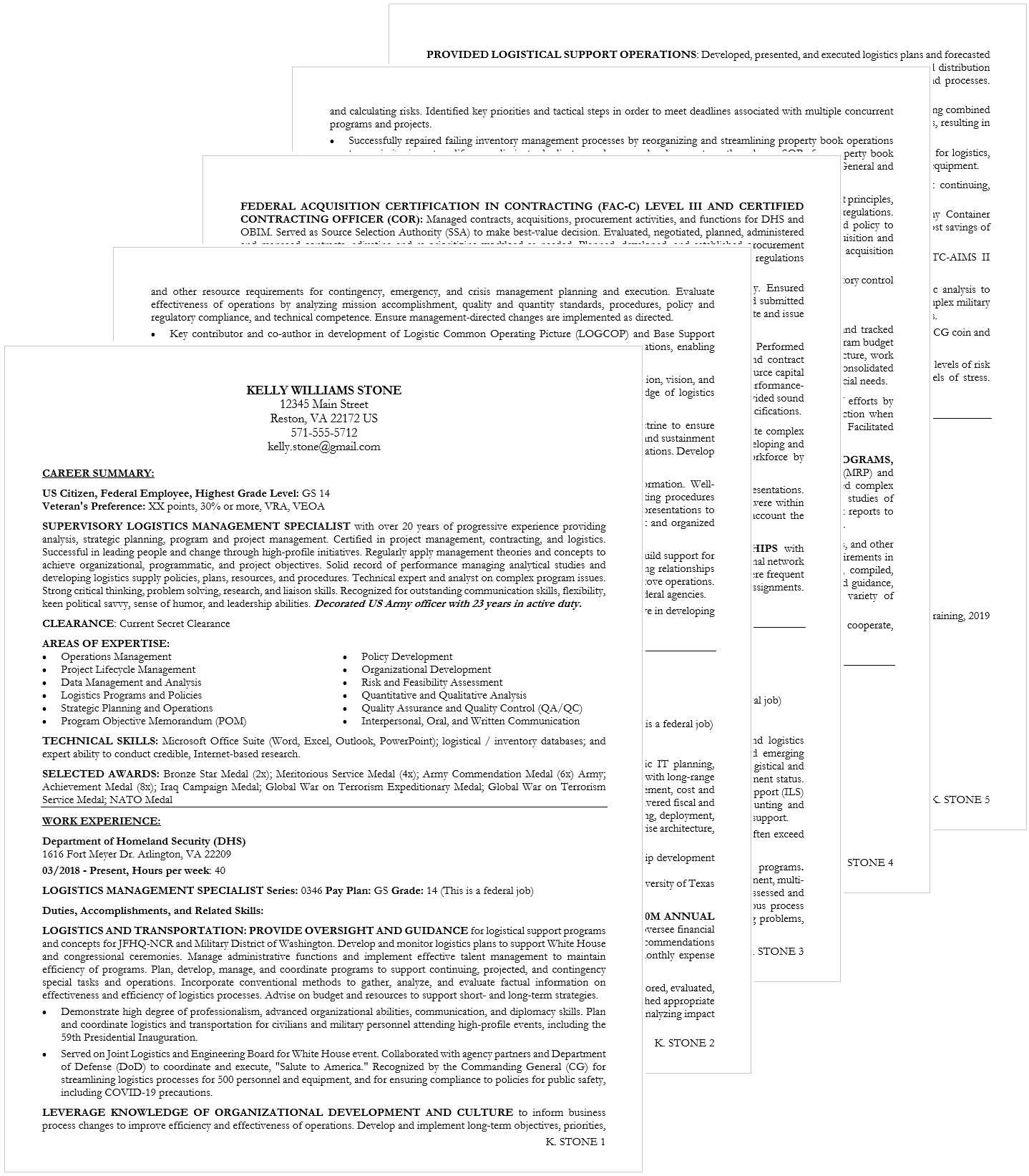
Your Federal Resume – The Next Step
Hopefully, this guide has provided you with helpful information regarding the complications, nuances, and time involved in creating an effective federal resume.
If after reviewing this guide, you’d prefer to take advantage of a federal resume writing service and use your valuable time on other elements of your job search, you can request a 1-on-1 consultation with one of our experienced team members. Whether you are a private sector employee looking for government work, a military service member seeking a transition to civilian work, or a federal employee looking to advance, we invite you to speak with one of our career advancement specialists so that we can optimally position you for your next challenge.